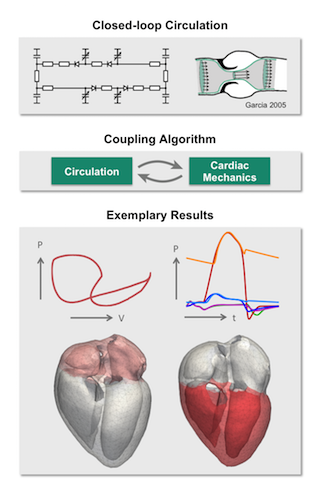Developing and Coupling a Lumped Parameter Model of the Closed Loop Human Vascular System to a Model of Cardiac Mechanics
- Typ:Masterarbeit
- Betreuung:
- Bearbeitung:
-
The heart’s purpose is to effectively pump blood through the body. Certain cardiac or vascular dysfunctions can impede the pumping efficiency of the heart. The consequences of such dysfunctions can only be studied, if the interactions of the heart and the circulatory system are considered. For a computer model of cardiac mechanics, it is therefore important to define realistic hemodynamic boundary conditions: The relation between the pressures inside the cardiac chambers and the corresponding changes in chamber volumes has to be defined at each time during the cardiac cycle. This can be done by coupling reduced order models of blood flow to the cardiac model. While open-loop models are sufficient to define the load on the heart during a specific phase of one single cardiac cycle, they are not sufficient in defining the load during several succeeding cycles. By feeding back the previously ejected blood during cardiac filling and thus preserving the total blood volume, a steady state can be reached with a closed-loop model.
The main objective of this thesis was to develop and implement such a closed-loop, lumped-parameter model of the human vascular system and a method to numerically couple this model to a finite element model of cardiac mechanics.

